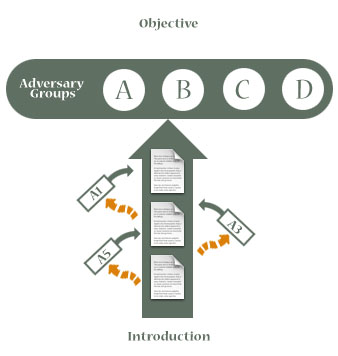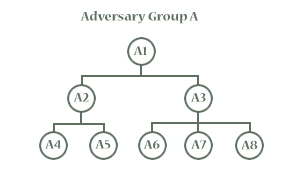The art of game mastering requires a broad collection of talents.
As a storyteller, referee, writer, artist, and actor. Your style
is a culmination of the balance of your talents. In this first article
I am exploring the model I use for crafting a campaign environment.
The real challenge is to tell a cohesive story and allow your players
to make a meaningful contribution to the world. Managed chaos is
what I am referring to.
I have a formula for managing the chaos that occurs in an environment
of brainstorming and role-playing. For the player the most important
thing in the long run will be feeling that they are masters of their
own fate. The more the players become aware that they are unable
to take control of their destinies the more rebellious or dissatisfied
they will become.
In diagram 1.0.1 the formula is laid out. All elements in green
represent the developed elements of a campaign. The orange elements
represent the players actions that take him outside the developed
environment.
At the base is the introduction to your world. Here is where you
introduce the players to the world in which they will be adventuring.
It is important at this point to give the players a compelling reason
for their characters to adventure together. Nothing inhibits good
role-playing like an improbable scenario.

The large green arrow represents the direction of the story you
conceived or that you are using as a part of a purchased campaign.
The documents in that arrow are the various prepared modules (adventures)
the players will complete on the way to their objective. The number
of modules is small for illustrative reasons.
Sooner or later you will face the moment when a player wants to
do something or follow a lead that is not scripted. Novice game masters
would make the mistake of trying to stop the players from going off
the story or offer an excuse that “I didn't prepare anything
for that”. In either case the player is robbed of an opportunity
to contribute to and expand the world.
Look above the big green arrow and you see a grouping of letters
titled "Adversary Groups". The various letters represent
different organizations whose goals and objectives stand between
the players and their objective. These organizations can be small
or large, related or unrelated. Lets assume that “A” represents
a band of goblins lead by an evil wizard. In the first module at
the bottom of the arrow the party is well on its way to finding out
about the recent goblin attacks on a nearby town when the Ranger
(controlled by a player character) in the party gets it in his mind
that he wants to take on the nearby orc tribe in the area. If the
consensus of the party is to go this direction, allow the ranger
some interaction with his favored enemy before introducing “A5”.
In this example “A5” is a character from the band of
goblins who is placed in the path of the party and used to draw the
party back into the scripted storyline. This can be an individual
or group, but their purpose is to lure the party back to the prepared
material.
The game master is really tested for creativity in these encounters
because the party is off track and needs to be subtly brought back.
If this encounter is mishandled the players may continue on their
predetermined route outside the main story line.
It is not important to bring the players back to your story right
away, often times some of the most compelling role-playing happens
in the sides stories that the players generate by exerting free will.
Eventually you will need to bring the players back to the story.
Use non-player characters from any of the adversarial groups or a
trusted ally to get them back to your prepared material.
This type of subtle control continues, using other members of the
organization that are more powerful, as the party grows in prowess.
In campaigns that run over greater lengths of time where other factions
interact with the party you can substitute members of other organizations
as appropriate to the encounter.
Side Stories
The side story is very important to character development and should
not be discouraged. The above diagram works on a macroscopic and
microscopic level. It can apply to the entire campaign or a single
adventure.
If we examine this metaphor further, each of the “Adversary
Groups” has a structure. I usually map it out with an organization
chart. These are common to business and military organizations. As
I introduce the members of and organization to the party I try to
start near the bottom of the organization chart. This usually represents
the lower level npc's or creatures in an organization.

As the campaign progresses the party will get to know the organization
though their interaction with the subordinates and or leaders. At
some point in the campaign the party will become particularly annoyed
with one of the “Adversary Organizations” to the point
that they focus their full attention on eliminating them. Now you
have their attention! This is a great opportunity for a sub-goal.
Nothing warms a party up for their campaign finale like taking out
one of the thorns in their side before moving on to the main event.
Sub-goals and adventures share a common element in that they are
vehicles that move the story to is conclusion.
In each of the worlds that are distributed by Gamepoint Worlds you
will find this formula used in creating a believable compelling worlds.
The more you work with it I think you will find that the tool has
uses in the real world as well. |


